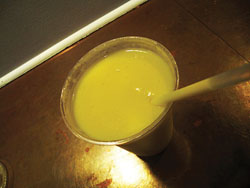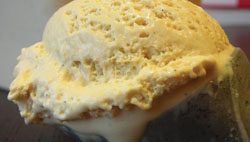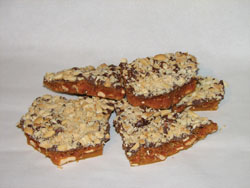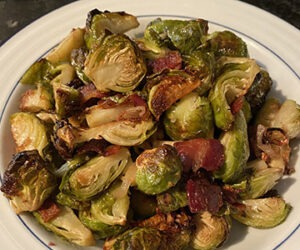Article
Malt on the Menu
Judie Giebel, technical services, Briess Malts & Ingredients Co., Chilton, WI, explains, “If we’re making liquid malt extract (LME) we cook it to 86 percent solids, and if we are making dry malt extract (DME) we dehydrate the liquid syrup to form solids that are then ground into powder.” Dried malt extract is not hopped because the dehydration removes hop compounds.
Homebrewers often use malt extracts that have been hopped to create a specific beer style. But home cooks use malt extracts, or malt syrups, for sweetness without a sugary edge, compatible with savory breads, crackers, vegetables, mustards and sauces. The flavor of malt extract makes it a wonderful match with nuts, mocha, cocoa and chocolate.
In the 1800s, malt was a staple of nutritional tonics, and malt syrups were thought to be especially good for babies. Malt-enhanced energy drinks such as the original form of Ovaltine were popular in England and Europe in the 1900s. But don’t confuse pure malt extract with malted milk, which is made of a blend of malt extract, wheat flour and whole milk. The malted milk powder used in fountain drinks was the invention of William and James Horlick, patented in Racine, Wisconsin in 1883.
Beer ice creams benefit from a swirl of caramel malt extract added to the ice cream maker as it freezes. “Briess’ CBW Sparkling Amber can be used in ice cream for smoothness,” says Judie Giebel. However, too much malt extract or wort can create a soft-serve, oozy texture to the dessert, so a light swirl is all that’s needed.
“It’s a little tricky to make a smooth, creamy malt ice cream from reduced wort,” said Darren Chadderdon, a former chef at Gordon Biersch’s Palo Alto brewpub in a phone interview. “If there is too much, it will interfere with the fine ice crystal formation that you want in a frozen dessert.” Guar gum is a natural ingredient that helps stabilize the crystal formation — I sometimes add just a little guar gum to the custard base of frozen malted custard, to keep the dessert smooth and creamy in texture.
Giebel says, “Light LME (nondiastatic, made from base malt) is a wonderful natural sweetener not only for ice cream (as it helps control crystallization), but also in any food that can benefit from low sweetness plus malty flavor (breads, crackers etc.). Caramel LME (nondiastatic, made from base and caramel malts) is excellent in pizza crust and other breads and shaped rolls. At a usage rate of about 3%, it not only adds a hint of great flavor but enhances fermentation and improves browning and crumb. Dark LME (nondiastatic, made from base and dark roasted malts like black malt) can provide natural color to hearth breads, sauces, gravies and all sorts of foods.”
Malt extract is a favorite secret ingredient of many professional bakers and pastry chefs. Diastatic malt powder or barley malt extracts are often used in professional bakeries to add nutrition, improve crumb texture and appearance, and enhance the keeping quality of the finished loaves. Breads that require second rises (pumpernickel, rye and other hearth breads) can benefit from a small dose.
That’s because professional bakers evaluate bread by many characteristics beyond flavor and freshness. Breads are judged by their volume, symmetry, crust color, crust crispness, break and shred, grain, texture, aroma and mouthfeel. Many bakers agree that adding diastatic malt to bread dough will contribute to yeast baking success.
Unlike most brewery-grade malt extracts that you find at your local homebrew shop, diastatic malt contains natural enzymes, mainly amylases and proteases. This type of malt acts as a dough conditioner. It helps soften the dough, adds to the elasticity for shaping the dough (especially important in pizza crusts and crackers). In addition, the amylase also breaks starch down into sugars, which helps feed the yeast and aids in browning. The proteases break the proteins in the flour down into amino acids, aiding yeast growth, as well as improving the flavor and aroma in breads. You can find diastatic malt powder at baking supply stores. If an extract is diastatic, it will say so on the label.
Just replace a tablespoon of sugar or sweetener in your favorite bread recipe with a half-teaspoon of diastatic malt powder. Add malt extract to the warm water used to dissolve the yeast, stir till blended, and mix it into the dough for the first rise. “Just don’t use too much or the dough will lose its structure and liquify,” says Giebel.
But beware of adding too much malt extract or diastatic malt powder, since the increased yeast activity can cause problems. As homebrewers know, carbon dioxide and alcohol are the normal byproducts of yeast metabolism. Though alcohol is delightful in beer, it is less so in dough. The bread will be “overproofed,” a baker’s term that translates into gummy, sticky dough that’s difficult to handle, and upon baking, yields a loaf that smells of alcohol, with a dense, unpalatable crust.
Non-diastatic malt is added simply as a sweetener or adding malt body, a hint of caramel color and flavor. With that in mind, be sure to use dried malt extract or unhopped malt extract.
The most abundant sugar in (nondiastatic) malt extract is maltose. Maltose is roughly half as sweet as glucose, a third as sweet as sucrose (table sugar) and about a fifth as sweet as fructose. It is roughly twice as sweet as lactose. You can use that as a rough guide if you are substituting malt dried extract for refined sugar in a recipe.
Malt extract also makes a superb natural substitute for sugar in marinades and barbecue sauces, as it contributes to browning, without the rapid burn or flare-ups from refined sugar. Malt in marinades will turn even the palest lobes of boneless, skinless chicken breasts into a golden-browned and appetizing entrée.
If you are adventurous, you can also make wort reductions from wort you collect from your all-grain brews. Wort boiled at atmospheric pressure cannot be condensed to the density of commercial malt extract without severely darkening it. However, you can make light syrups from wort and calculate the sugar content based on the specific gravity (see recipes). Here are some recipes to inspire you to put malt on the menu.
MALTED ICE CREAM
Ingredients
2 cups heavy cream
1⁄2 cup milk
4 oz. (~100 mL) dark beer (such as a bock or schwarzbier)
2 tbsp. barley malt syrup
1⁄2 cup cane sugar
1⁄4 cup powdered milk
4 egg yolks
Whole vanilla bean, cut into two, inside seeds removed (about 1⁄2 tsp. seed paste)
pinch of salt (less than 1⁄8 tsp.)
1⁄4 tsp. guar gum (optional – helps ice cream ripen and crystallize smoothly)
Step by Step
In a large stainless-steel mixing bowl, whisk together cream, milk, beer, barley malt syrup, sugar, powdered milk, egg yolks, vanilla bean paste and a pinch of salt. Whisk until smooth. Place 2 cups water in a large, 2-quart heavy saucepan and bring to a boil over high heat. Reduce heat to low, and when water is simmering, place the mixing bowl over the pan – the base of the bowl should fit securely inside the pan, but not sit in the hot water as the custard should be heated by steam alone. Whisk the egg-beer-cream mixture continually over the steam until the blend is thickened and temperature reaches 180 °F (82 °C). Do not let water boil or the mixture will curdle. Remove from the heat and add guar gum if desired. Whisk well to blend, and then pour the custard through a fine mesh sieve into a large glass bowl. Cool until lukewarm, and then cover and chill for 4 hours or overnight. Freeze the custard in an ice cream maker, according to the manufacturer’s instructions. Place the frozen ice cream in a large, resealable container and freeze for 6 hours, or until solid enough to scoop. Makes 1 scant quart.
Note: David Lebovitz, in his cookbook, The Perfect Scoop (Ten Speed Press, 2007), recommends the addition of chopped malted milk balls to his version of malted ice cream, made with malted milk powder instead of barley malt extract. You can also spread the soft ice cream on sliced thin stout brownies to make ice cream bars, topped with malt chocolate ganache, assembled, sliced and frozen until firm.MALT CHOCOLATE GANACHE
Ingredients
3 oz. (85 g) semisweet chocolate
1⁄4 cup whipping cream
1 tbsp. dark malt extract
1⁄3 cup powdered sugar, sifted
Step by Step
Melt chocolate in microwave on high (100% power) 2 minutes, then stir until completely melted, and stir in cream and malt extract. Beat with electric mixer on high speed until fluffy, then gradually add powdered sugar to get a thicker frosting. Makes 1⁄2 cup.
SPICED MALT-NUT CRUNCH
Ingredients
1⁄2 cup butter
3 tbsp. dark malt extract
2 tbsp. light corn syrup
1⁄2 cup dark brown sugar
1⁄4 cup cane sugar
1⁄2 tsp. baking soda
1 tsp. ground ginger
1 tsp. ground black pepper
1 tsp. salt
1 cup shelled raw peanuts
1 cup shelled raw almonds
1⁄4 cup ground caramel malted barley (optional)
4 cups popcorn
Step by Step
In a large heavy Dutch oven over medium heat, combine the butter, malt extract and sugar. Stir until butter melts and mixture begins to boil. Reduce heat to low and continue cooking, without stirring, for 5 minutes.
Preheat oven to 300 °F (150 °C). In a small bowl, mix together baking soda, ginger, pepper and salt. Remove pan from heat and stir in baking soda and spices, stirring well to blend evenly. Hot syrup will foam a bit. Stir in nuts and ground malted barley if using, mix well, and then stir in popcorn to coat evenly. Scrape mixture onto parchment-lined baking sheet and spread evenly.
Bake 15–20 minutes, stirring with a long-handled wooden spoon so mixture toasts evenly and remove from heat. Break into chunks once cool. The mixture will be a little sticky. Makes 6 cups.
MALTY MUSTARD

Ingredients
1⁄4 cup brown sugar
1 cup dark ale
2 tbsp. brown mustard seeds
2 tbsp. powdered mustard
1⁄2 cup apple cider vinegar
2 shallots (peeled and minced)
1 tsp. salt
1⁄2 tsp. finely ground black pepper
2 egg yolks
2 tbsp. butter (melted)
Step by Step
Blend all ingredients in a blender or food processor on high until smooth. Spoon mixture into the top of a double boiler. Cook over simmering (not boiling) water until thickened and steaming, about 10 minutes, whisking often to prevent curdling. Let cool to room temperature, scrape mustard into a resealable, sterilized glass jar. Chill before serving. Mustard keeps, refrigerated, for up to 2 weeks. Makes 2 scant cups mustard.
MALTY MANGO MARINADE

This piquant blend of fresh mango, pureed with Pilsner, lemon zest, and herbs, adds flavor and moisture to white, bland fish such as cod or haddock. Punch up the seasonings if using this marinade with a more robust, oily fish such as bluefish or shark.
Ingredients
1⁄4 cup olive oil
12 oz. (355 mL) Pilsner beer
1 tsp. minced lemon zest
1⁄2 cup diced mango
2 tsp. minced summer savory (fresh)
1⁄2 tsp. pink peppercorns
1 tsp. lemon juice
1 tbsp. barley malt extract
1 tsp. minced green scallion tops or chives (fresh)
1.5–2.0 lbs. (0.68–0.91) fish filets
Step by Step
Mix all the ingredients in a blender. Pour over fish placed in a glass or other nonreactive dish. Cover and chill for at least 1 hour. Grill for 2 to 3 minutes per side, depending on the thickness of filet or until fish is opaque throughout and golden on the surface. Serve immediately.
PORTER PORK PAINT
Ingredients
1⁄2 cup butter
1 cup diced sweet onion
1⁄4 cup malt vinegar
Juice of 1 lemon
1⁄4 cup barley malt extract
1⁄4 cup Worcestershire sauce
3 tbsp. mild or hot paprika
2 tbsp. dry mustard
1–2 tsp. white pepper
12 oz. (355 mL) Porter
Step by Step
Combine all ingredients in a medium (two-quart) nonreactive saucepan and simmer 20 minutes. Puree with hand-held stick blender, or let cool and puree in a standard blender. Excellent on pork ribs. Yields about 3 cups.
MALTED HERB-CHEESE BREAD
Ingredients
2 1⁄2 cups self-rising flour
1⁄4 cup whole wheat flour
12 ounces amber ale
1 tbsp. dried dill weed
3 tbsp. ricotta cheese
2 tbsp. melted butter
1 tbsp. malt extract
Step by Step
Preheat oven to 375 °F (190 °C). Mix all ingredients in a large mixing bowl, by hand with a spatula (do not use an electric mixer). Mix just until batter forms. Scrape sides of bowl, stir, and scrape batter into a buttered bread loaf pan. Tap pan on the counter top to settle batter, and smooth top with spatula. Bake 45 minutes, or until loaf is well browned. Let cool 10 minutes before removing from baking pan. Loaf is crumbly in texture, better torn than sliced. Makes one loaf.
MALTED PRETZEL ROLLS
Ingredients
2 cups warm water (105–110 °F/41–43 °C)
one (1⁄4-ounce) envelope active dried yeast
4.5 to 5 cups bread flour
2 tbsp. cane sugar
1⁄2 tsp. finely ground salt
2 tbsp. canola oil, divided
Kosher salt or pretzel salt (for topping)
6 cups water
3 tbsp. baking soda
2 tbsp. dark malt extract
Step by Step
For best results, use a stand mixer to prepare the pretzel dough. Place 2 cups of warm water in the bowl of a stand mixer and stir in the yeast. Set aside for 5 minutes, or until the yeast bubbles.
Place flour, sugar, and 1⁄2 tsp. salt in a large bowl and whisk well until fluffy. Once yeast is ready, secure the bowl on the stand mixer, attach the dough hook, and add flour all at once. Mix on low until dough forms, then increase to medium to knead the dough until smooth, about 6–8 minutes.
Form dough into a ball, place in a large mixing bowl, oiled with 1.5 tbsp. canola oil, and turn ball to coat evenly in oil. Cover with a clean, damp tea towel, and let rest in a warm place until dough doubles, about 1⁄2 hour. Line a baking sheet with parchment paper, coat paper with remaining vegetable oil, and set aside.
Punch down the dough and knead for 2 minutes. Divide dough in half, in half again, and repeat until you have 16 pieces; form into rectangular or oval rolls. Place rolls on the baking sheet and cut four 2-inch diagonal slashes across the top of each. Cover with a damp towel and let dough rise in a warm place until almost doubled in volume, about 15 to 20 minutes.
Preheat oven to 425 °F (220 °C) and bring 6 cups water to a boil in a large 2-qt. (2-L) saucepan over high heat. Stir baking soda and malt extract into boiling water. Using a slotted spoon, place doughy rolls, two at a time, in the boiling malted water. Turn and stir so rolls don’t stick together, and boil about 30 seconds on each side. With the slotted spoon, remove rolls, drain, and place on the baking sheet, cut side up. Repeat with remaining dough rolls. Sprinkle the boiled rolls well with kosher or pearl salt. Bake 12 to 15 minutes, or until well browned. Let the bread cool to lukewarm and serve.
HOMEMADE MALT SYRUP
Ingredients
malted barley (your choice)
Step by Step
When making an all-grain beer, mash as usual and recirculate. Making a thick, single-infusion mash and not adding any water to mash out will help you make a thicker extract. Collect some of the first runnings, before any sparge water has been added. Measure the volume of this wort and its specific gravity. Boil the wort gently until it thickens, stopping before it darkens excessively or starts tasting like scorched sugar. You can estimate the percentage of sugar in your malt extract by multiplying the initial volume times the density measured in °Plato. Divide this product by the final volume of the syrup. This number is the approximate percentage of sugar in the condensed syrup.
DIASTATIC WORT
Ingredients
domestic 2-row or 6-row malt
water (w/ Ca2+ > 100 ppm)
Step by Step
Mash the grains in a thick mash at 148 °F (64 °C) for 20 minutes. Do not raise the temperature for a mash out. Recirculate and draw off clear wort. Do not boil. Cool wort and use within a few hours of making it. (Otherwise, it will turn sour.) The density of your solution (in °Plato) gives the approximate sugar content (as a percent). You can substitute this for a small amount of the liquid called for in any bread recipe.
Written by Lucy Saunders
Issue: November 2009





